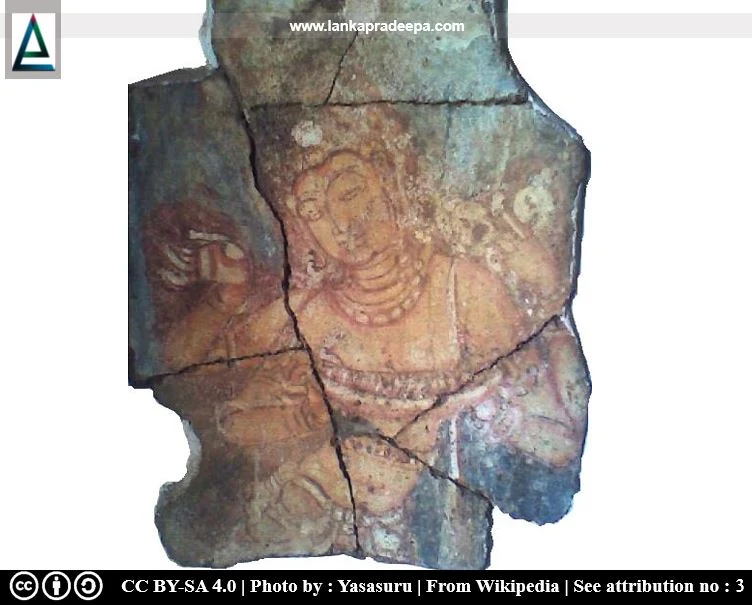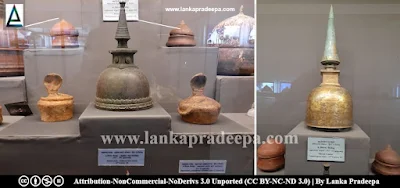
|
The Stupa and image house at Mahiyangana Viharaya |
Mahiyangana Raja Maha Viharaya (Sinhala: මහියංගන රජමහා විහාරය) is a Buddhist site situated on the east bank of Mahaweli Ganga River near Mahiyanganaya town in Badulla District, Sri Lanka. The site is considered an important shrine by pilgrims as its history is related to the first arrival of the Buddha in Sri Lanka.
Legends
Mahiyanganaya is associated with the story of the first visit of the Buddha to Sri Lanka. Therefore, the history of this temple goes as far back as the 6th century B.C. (Wijesekara, 1990). Local chronicles such as Mahavamsa record that in the 9th month of his Buddhahood, on a Duruthu (January) full moon Poya day, the Buddha visited the island of Sri Lanka to subdue Yakkhas, who had assembled at the site of the modern Mahiyangana Stupa (Priyadarshani & Gunasena, 2017; Wijesekara, 1990). The Buddha is said to have appeared at Mahanaga Garden, the customary meeting place of the Yakkas, and dispersed them to an island named Giri Divaina (Nicholas, 1963). Then the Buddha preached the Dhamma to the gods who had gathered there and as a result, some of the gods attained Margapala. After hearing the Dhamma on this occasion, the prince of Devas, Mahasumana of the Samanthakuta mountain (Sri Pada Mountain) asked Buddha for something to worship and the Buddha gave him a handful of his hair (Ward, 1952). Mahasumana is said to have enshrined the hairs at the spot where the Buddha had sat and built a Stupa 7 cubits tall.
About forty-four years later (after the death of the Buddha) an Arhat named Sarabhu Thera, a disciple of Arhat Sariputta Thera, recovered the Greeva Dhathu [the cervical spine (neck bone) relic] of Buddha from the funeral pyre and brought it to Sri Lanka and laid in this Stupa by restructuring it with golden coloured stones (Medhawanna Pashana) to a height of 12 cubits (Ward, 1952; Wijesekara, 1990).
According to these legends, the Mahiyangana Stupa (as well as the Stupa of Girihanduseya in Trincomalee) was built in Sri Lanka during the lifetime of the Buddha (Ray, 1959). Therefore this Stupa could be one of the earliest Buddhist monuments in the world. However, these legends are full of miraculous details and no monument that can be dated to a time before the introduction of Buddhism to Sri Lanka has been identified in the country yet (Ray, 1959).
History
The Mahiyangana Stupa was renovated from time to time by various Kings. Prince Uddha Culabhaya, the brother of King Devanampiyatissa (247-207 B.C.) constructed the Stupa to a height of 30 cubits over the earlier Stupa (Nicholas, 1963; Wijesekara, 1990). King Dutugemunu (161-137 B.C.) raised the Stupa to a height of 80 cubits. According to chronicles, Dutugemunu had the first battle of his campaign against King Elara at Mahiyanganaya and defeated a local Tamil commander named Chatta (Nicholas, 1963).
Other rulers such as King Voharika Tissa (209-231 A.D.), Sena II (853-887 A.D.), Kassapa IV (898-914 A.D.), Vijayabahu I (1055-1110 A.D.), and Parakramabahu VI (1410-1468 A.D.) had carried out donations and maintenance work at the temple (Nicholas, 1963; Wijesekara, 1990). The Sorabora Wewa Pillar Inscription records that King Udaya IV (946-954 A.D.) had visited the temple, Miyugun Mahaveher (Nicholas, 1963). The Gal Potha Inscription of King Nissankamalla (1187-1196 A.D.) also reveals that he effected repairs to Miyangunu-mahavehera (Nicholas, 1963).
The reconstruction of the Stupa was finally started in the 1940s and ended in the 1960s with the completion of a new pinnacle for the Stupa.
Relic Chamber Paintings
On the 4th of January 1951, the Archaeological Survey Department of Ceylon excavated a relic chamber of Mahiyangana Stupa and found a large number of paintings fragments on the floor (Ward, 1952). The chamber/repository was located above the ground at a height of 22 feet and had been covered with three large stone slabs (Wijesekara, 1990). The paintings had been originally drawn on their inside walls but at the time it was discovered most of them had peeled off and fallen to the floor of the vault (Wijesekara, 1990).




Among the antiquities found inside the relic chamber was a silver coin belonging to the reign of Rajendra Chola [(1014-1044 A.D.) Wijesekara, 1990]. Depending on this and other findings, the paintings of Mahiyanganaya Stupa have been dated to the 11th century but the style of some paintings is believed to be the work of the 8th, 9th or 10th centuries (Ward, 1952; Wijesekara, 1990).
A Protected Site
The ancient Stupa and the Saman Devalaya situated in the Mahiyanganaya Raja Maha Vihara premises in the Mahiyanganaya Divisional Secretary’s Division are archaeological protected monuments, declared by a government gazette notifications published on 22 November 2002.


Related Posts
Read Also
References
Books, Journal Articles, Government Gazette Notifications
1) Nicholas, C. W., 1963. Historical topography of ancient and medieval Ceylon. Journal of the Ceylon Branch of the Royal Asiatic Society, New Series, vol VI, Special Number: Colombo. Royal Asiatic Society (Ceylon
Branch). pp.48-49.
2) Priyadarshani, S.A.N.; Gunasena, I.P.P., 2017. Pauranika Sthana Ha Smaraka: Badulla Distrikkaya (In Sinhala). Department of Archaeology.
ISBN: 955-9159-48-8. pp.5-7.
3) Ray, H. C. (Editor in Chief), 1959. University of Ceylon: History of Ceylon (Vol 1, part I). Ceylon University Press. pp.136-137.
4) The Gazette of the Democratic Socialist Republic of Sri Lanka. No: 1264. 22 November 2002.
5) Ward, W.E., 1952. Recently discovered Mahiyangana paintings. Artibus Asiae, 15(1/2), pp.108-113.
6) Wijesekara, N. (Editor in Chief), 1990. Archaeological Department Centenary (1890-1990): Commemorative Series: Volume V: Painting. pp.48-49.
Location Map
Dynamic Google Map
Attribution
To Whom
1) A deity from the Relic chamber of Mahiyangana Stupa by Yasasuru is licensed under CC BY-SA 4.0
2) Buddha seated under a Bodhi tree. Relic chamber of Mahiyangana stupa by Yasasuru is licensed under CC BY-SA 4.0
3) Vishnu bearing a tray of flowers, Relic chamber of Mahiyangana Stupa by Yasasuru is licensed under CC BY-SA 4.0
4) Robed figures, Relic chamber of Mahiyangana Stupa by Yasasuru is licensed under CC BY-SA 4.0
5) LankaPradeepa.com extends its gratitude to Malsha M. Ranasinghe for providing the necessary photographs required for this article. All the photos are published here with the permission of the author.




